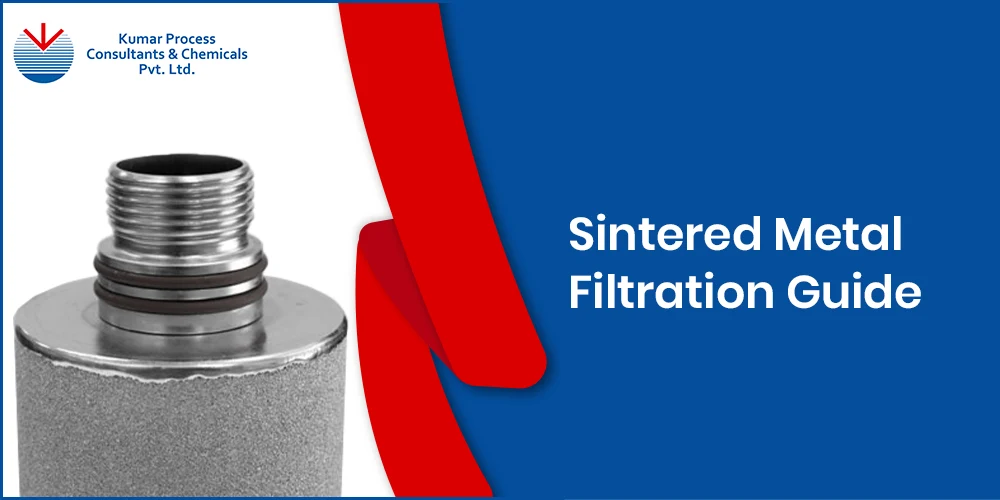Introduction to Sintered Metal Filters

Sintered metal filters are advanced filtration solutions made using metals. They are of two types:
1) Powder sintered metal filters are designed by compressing and sintering metal powders into a porous, rigid structure.
2) Woven metal meshes are heated together to produce multilayered sintered woven metallic mesh filters.
These two filters, which are mainly used in various kinds of industries, are well-known for their durability, prolonged lifespan, and unique purifying abilities. Stainless steel, titanium, nickel, and alloys based on nickel are widely used materials.
What is Sintering?
Metals undergo heating beyond their point of melting throughout the sintering process with the aim to create connections by solid-state dispersion. Sintering enhances power and rigidity while preserving material authenticity, in against melting.
Manufacturing Steps of Powder Sintered Metal Filters
- Metal Powder Preparation :
Making the metal powder is the beginning process in the manufacturing of sintered metal filters. This involves breaking down metals into small particles by applying operations like atomization, crushing, or chemical decomposition. Later on, the powders are crushed to the required size.
- Pressing :
When the metal powder is ready, it can be formed into the necessary form at room temperature using a casting tool with elevated pressure. In order to guarantee that the powder particles compress effectively, the pressure utilized in this section changes depending to the metal's flexibility. The fragmented powder gets pressed into a solid filter form, providing the process of sintering the durability that it required.
- High-Temperature Sintering :
The compressed metallic powder undergoes high-temperature sintering after molding. The metal particles become connected at extremely high temperatures during this process, though they don't reach their boiling point. The filter's strength is enhanced by this meticulously controlled heating process, which further makes it feasible to accurately control density. Varieties of sintered media generally range within 0.1 and 100 microns, ensuring efficient filtering for many different kinds of applications.
Manufacturing Steps of Multilayered Sintered Metal Filters
- Metal mesh weaving
Metal fibres of the required material and thickness are woven into a metal fabric. This results in a thin metallic cloth having a uniform porous structure. Depending on the target filter, different weaving techniques and metal fibres are used in this process
- Layup of metal meshes
As per the required filter, these different meshes are layered in a specific order. This order will be retained in the final multilayer wire mesh laminate filter.
- Sintering
Similar to powder sintered filters, these meshes undergo the process of sintering in order to bond them together.
- Straightening
Once sintered into a single porous mesh, the sheets are straightened for further processing.
Uses of Sintered Metal Filters
- Stainless Steel Sintered Filters
- High corrosion resistance.
- Strong mechanical integrity for high-pressure applications.
- Used in petrochemical, pharmaceutical, and food industries.
- Titanium Sintered Filters
- Exceptional corrosion resistance in aggressive environments.
- Ideal for marine industries and gas purification
- Lightweight yet highly durable.
- Hastelloy Sintered Filters
- Exceptional corrosion resistance in Chloride containing environments.
- Used majorly in Chemical processing industries.
- Expensive but durable
Advantages of Sintered Metal Filters
- High Filtration Efficiency: Submicron particles are absorbed through a uniform pore distribution.
- Durability: Ability to deal with mechanical stress, corrosion, and extreme temperatures.
- Chemical Compatibility: The ability to withstand exposure to severe chemicals is known as chemical compatibility.
- Reusability: Simple to maintain and clean.
- Customizable: Adjustable pore size and thickness for specific applications.
How Do Sintered Metal Filters Work?
Sintered metal filters function by trapping contaminants while allowing fluids or gases to pass through. Key operational factors include:
- Contaminant Retention: Filters particles based on porosity.
- Backwash Ability: Uses pressurized gas or filtrate to clean the filter.
- Pressure Drop Management: Ensures consistent flow rate and efficiency. Multilayer wire mesh laminates have a lower pressure drop as compared to powder sintered filters.
Applications of Sintered Metal Filters
- Oil & Gas: Removes contaminants from natural gas and petrochemicals, ensuring smooth operations.
- Chemical Processing: Filters aggressive chemicals without degradation.
- Water Treatment: Remove solid impurities in the entire purification processes.
- Pharmaceutical Industry: The metallic nature of these filters allows them to undergo an infinite number of steam sterilizing cycles. They are ideal for reducing the particulate load on the final sterile membrane filters.
- Food & Beverage: Maintains hygiene by removing rust particles from boilers used in rice cooking and general heating processes
In conclusion
For efficient and powerful filtration in various kinds of industries, sintered metal filters are essential. They are ideal for challenging uses due to their versatility, resilience, and corrosion resistance. These are a viable and reasonably priced filtration choice thanks to their improved reliability and effectiveness made possible by regular servicing and an understanding of filtration demands.


